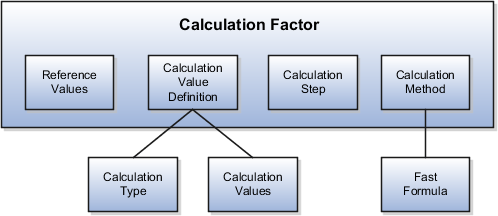Overview of Calculation Factors
Calculation factors define data-driven rules for calculating complex payroll elements, such as statutory deductions. Some elements may have a large number of calculation factors, one for each unique set of rules, ranges, and references values.
Calculation factors create an association between an element, a calculation step, and a calculation value definition.
The payroll run determines which calculation factor to use based on the reference values and calculation rules of the element being processed.
For example, a calculation factor for a tax deduction element might define:
-
A context reference, such as a city or state
-
The calculation value definition, such as a 4 percent tax rate on balances under 50,000
-
Optionally a calculation method and calculation step
Navigate to the Element task and select an element to view and manage calculation factors.
To view and manage calculation factors, follow these steps:
-
Select the Payroll Calculation Information task from Quick Actions list of the Payroll section.
-
Select the calculation component.
-
In the Calculation Overview section, expand the Related Elements node.
-
Expand the Calculation Factors node to display a list of all calculation factors associated with the element.
-
Create new calculation factors and edit existing ones that have an update status of Unlocked.
Aspects of a calculation factor are shown in the following figure:

Reference Values
A calculation factor may be associated with up to six references that define its context. For example, the calculation of a social insurance deduction might vary based on a person's age and employment status.
Each reference has a reference number that determines the order in which it's evaluated for processing relative to other references.
Navigate to the Calculation Information task and search for a payroll component to view and manage calculation factor reference information.
Calculation Value Definition
Calculation factors create an association between an element, calculation step and a calculation value definition. The calculation value definition defines the calculation type, such as flat amount or flat rate. The calculation rates and rules may vary based on the amount subject to calculation. Predefined calculation value definitions are provided for statutory and involuntary deductions.
Navigate to the Payroll Calculation Value Definition task to view and manage value definitions.
Calculation Step
A calculation step is a name or a label assigned to a calculation factor to identify its role in a complex payroll calculation.
For example, a time calculation can consist of several parts, such as:
-
Calculate hourly worked
-
Calculate hourly rate
And when calculating an income tax deduction, the payroll run can do the following:
-
Calculate allowance
-
Calculate exemptions
-
Calculate tax
This tax deduction might be defined as a single element with multiple calculation steps, each defined in a separate calculation factor. You can assign the same calculation step to more than one calculation factor. Calculation steps are optional.
Navigate to the Payroll Calculation Information task to view and manage calculation steps.
Range Values
Range values capture values required for the calculation. The type of information captured is controlled by the calculation type of the value definition such as flat amount, rate (percentage) or date.
Navigate to the Payroll Calculation Value Definition task to view and manage range values.
Calculation Methods
A calculation method references a single fast formula. It's an optional component of a calculation factor. Calculation methods operate at a higher level than the calculation types defined in the calculation value definition. They provide a wrapper around the calculation of a deduction by retrieving values from a calculation value definition, applying a formula, and returning the final deduction amount for the current run.
For example, if the calculation method is set to Cumulative, which references the Core Cumulative fast formula, then the calculation process returns the total deduction amount as a cumulative year-to-date amount. Accrual calculations for payroll balance calculations typically restart at the beginning of each calendar year. This is another type of calculation method. In this case the plan rule for the accrual term start date is January 1.
Navigate to the Payroll Calculation Information task to view and manage calculation methods.